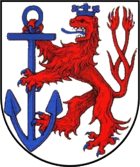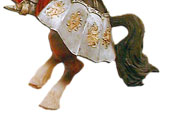| Dockings and Events |
|
| Museum Ship in Düsseldorf starts on 04.01. till 30.01.2008 |
 |

Our location in Düsseldorf: Vikingrivercruises Steiger 2 Rheinterrassen Tonhallenufer

When the Roman Empire was strengthening its position throughout Europe, a few Germanic tribes clung on to their marshy territory off the eastern banks of the Rhine River.
In th e 7th and 8th centuries, the odd farming or fishing settlement could be found at the point where the small river Düssel flows into the Rhine. It was from such settlements that the city of Düsseldorf grew. e 7th and 8th centuries, the odd farming or fishing settlement could be found at the point where the small river Düssel flows into the Rhine. It was from such settlements that the city of Düsseldorf grew.
The first written mention of the town of Düsseldorf dates back to 1135 (then called Düsseldorp). It was told that under Emperor Friedrich Barbarossa the small town of Kaiserswerth, lying to the North of Düsseldorf, became a well fortified outpost, where soldiers kept their watchful eyes over every movement on the Rhine. Kaiserswerth eventually became a suburb of Düsseldorf in 1929.

In 1186 Düsseldorf came under the rule of Berg. The counts of Berg moved their seat to the town in 1280.

14 August 1288 is one of the most important dates in the history of Düsseldorf as it was on this day that the sovereign Count Adolf V of Berg granted the village on the banks of the Düssel city rights.

A market square sprang up on the banks of the Rhine and the square was protected by city walls in all four directions. In 1380, Düsseldorf was made regional capital of the Duchy of Berg. During the following centuries several famous landmarks were built, including the Collegiate Church of St. Lambertus. In 1609, the ducal line of Jülich-Berg-Cleves died out, and after a virulent struggle over succession, Jülich and Berg fell to the Counts of Palatinate-Neuburg, who made Düsseldorf their main domicile, even after they inherited the Palatinate, in 1685, becoming now Prince-electors as Electors Palatine.

Düsseldorf's growth was even more impressive under the leadership of Johann Wilhelm II (r. 1690-1716) in the 18th century, also known to his people as Jan Wellem. Greatly influenced by his wife Anna Maria Luisa de' Medici, the art lover designed a vast art gallery with a huge selection of paintings and sculptures that were housed in the Stadtschloss (city castle).

After the death of childless Jan Wellem, the flourishing royal capital fell back to hard times, especially after Elector Karl Theodor inherited Bavaria and moved the electoral court to Munich. With him he took the art collection, which became part of what is now the Alte Pinakothek in Munich. Destruction and poverty struck Düsseldorf after the Napoleonic Wars.

By the mid-19th century, Düsseldorf enjoyed a revival thanks to the Industrial Revolution as the city boasted 100,000 inhabitants by 1882; the figure doubled in 1892.

However, the First and Second World Wars soon plunged Düsseldorf into depression. During World War II, the city was virtually reduced to a pile of rubble as round-the-clock air attacks took their toll.

In 1946 Düsseldorf was made capital of the federal state of North Rhine-Westphalia.

The city's construction proceeded at a frenetic pace and the economic transformation saw Düsseldorf growing into the wealthy city of trade, administration and service industries as it is known today.

Düsseldorf has the third largest Jewish community in Germany of about 7.300 members, which is more than 1% of the city's population. |
|
 |
|
| |
|
|
|

